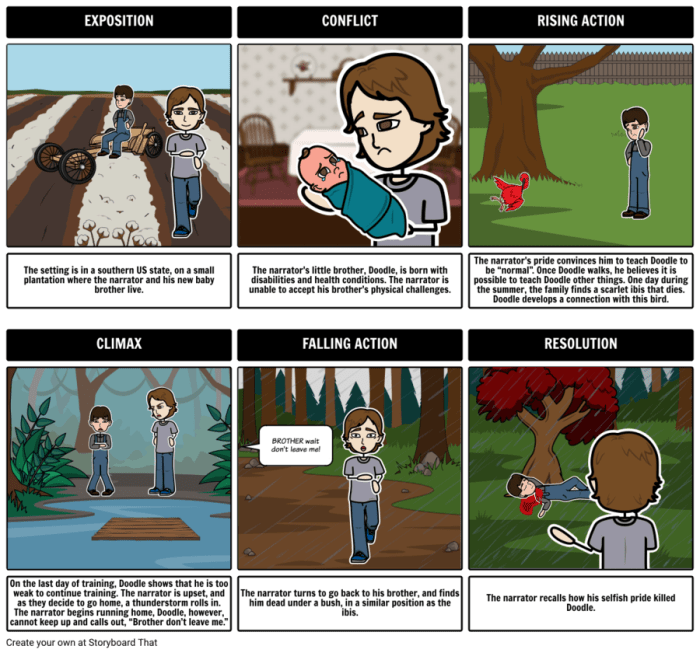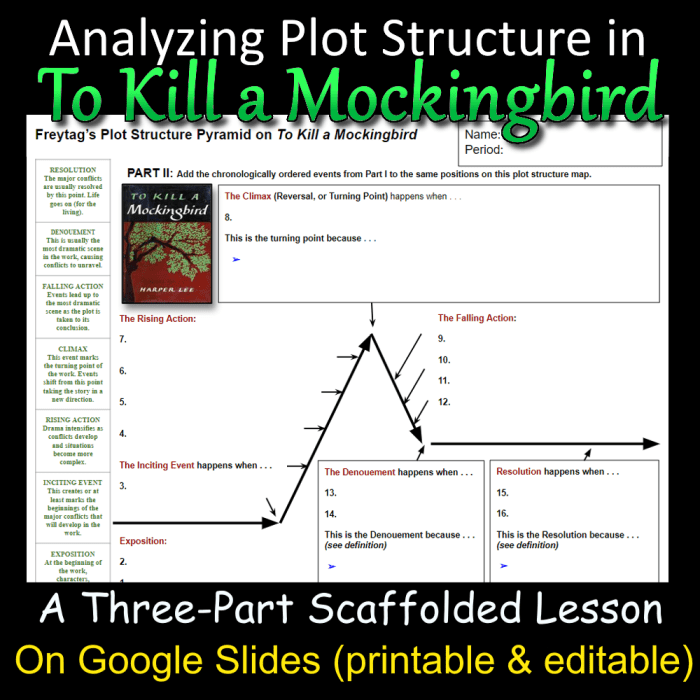Plot diagram of to kill a mockingbird – The plot diagram of Harper Lee’s “To Kill a Mockingbird” provides a comprehensive framework for analyzing the novel’s intricate narrative structure. This diagram elucidates the key events and conflicts that drive the story, shaping the characters and themes that resonate deeply with readers.
As we delve into the plot diagram, we will explore the exposition, rising action, climax, falling action, and resolution, examining how each stage contributes to the novel’s overall impact and enduring significance.
Introduction

Harper Lee’s “To Kill a Mockingbird” is a seminal work of American literature, renowned for its poignant exploration of racial injustice and its lasting impact on the human condition. This plot diagram analysis will delve into the novel’s intricate structure, examining the key events that shape its narrative and convey its powerful message.
Exposition
The novel is set in the fictional town of Maycomb, Alabama, during the 1930s. The story is narrated by Scout Finch, a young girl who witnesses firsthand the prejudices and injustices that permeate her community. The initial conflict arises when Tom Robinson, a black man, is falsely accused of raping a white woman, Mayella Ewell.
Rising Action

- Atticus Finch, Scout’s father, agrees to defend Tom despite the town’s hostility towards him.
- The trial becomes a battleground for racial prejudice, with the evidence against Tom being fabricated.
- Scout and her brother Jem witness the trial and are deeply affected by the injustice they see.
Climax
The climax of the novel occurs when Tom Robinson is found guilty despite overwhelming evidence of his innocence. This verdict shocks and devastates the Finch family and the few others who believed in Tom’s innocence.
Falling Action
- Bob Ewell, Mayella’s father, seeks revenge on Atticus and the Finch children for defending Tom.
- Boo Radley, a mysterious neighbor, intervenes and saves Scout and Jem from Ewell’s attack.
- Ewell is killed in the struggle, and Boo’s true nature as a gentle and compassionate individual is revealed.
Resolution
The novel concludes with Scout reflecting on the lessons she has learned about prejudice, justice, and the complexities of human nature. She realizes that the true “mockingbirds” in the story are those who are innocent and harmless, yet are targeted by injustice and hatred.
Symbolism and Motifs

Throughout the novel, Lee employs various symbols and motifs to enhance the narrative and convey deeper meanings. Examples include:
- The mockingbird: represents innocence, vulnerability, and the destructive power of prejudice.
- The Radley house: symbolizes the isolation and fear that can result from social prejudice.
- The courtroom: represents the battleground where justice and prejudice collide.
Character Development: Plot Diagram Of To Kill A Mockingbird
The novel features a cast of well-developed characters who undergo significant growth and transformation throughout the story. Scout Finch, in particular, emerges as a strong and resilient protagonist who learns to challenge societal norms and fight for what is right.
FAQ Explained
What is the significance of the exposition in “To Kill a Mockingbird”?
The exposition establishes the setting, characters, and initial conflict, providing the foundation for the subsequent events of the novel.
How does the rising action contribute to the development of the conflict?
The rising action presents a series of escalating events that intensify the conflict between prejudice and justice, building tension and anticipation.
What is the turning point of the novel?
The climax marks the turning point where the conflict reaches its peak, with the trial of Tom Robinson serving as a pivotal moment.
